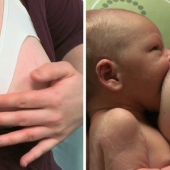How to start breastfeeding?
Making the decision to breastfeed is a personal matter. Although doctors strongly recommend breastfeeding, the decision is up to “you and to your body’s ability to do it”. I have some tips for you to start breastfeeding.
What Are the ABCs of Breastfeeding?
A = Awareness: Watch for your baby's signs of hunger, and breastfeed whenever your baby is hungry. This is called "on demand" feeding.
B = Be patient: Breastfeed as long as your baby wants to nurse each time. Infants typically breastfeed for 15 minutes on each breast.
C = Comfort: This is key. Relax while breastfeeding, and your milk is more likely to "let down" and flow. Get yourself comfortable with pillows as needed to support you begin to breastfeed. Wear wide clothes, put your hair up, listen to music, make sure nothing is bothering you while you feed, and so on.
The first time you hold your newborn is a great time to start nursing. You can be in a sitting/semi-sitting position. At the beginning, your body will produce very small amounts of a special milk called colostrum. It will be enough for your baby to fill up, so don’t worry about the amounts just yet. Now, let’s get started
1. Position yourself comfortably. There are several feeding positions that you can choose from. If you’re in the sitting position: have proper back support, place a pillow on your lap to help you keep your back straight and arms resting on it. Support your feet by a footrest if you like. Remember: having an arched back or tense chest muscles may reduce the milk flow. So, relax!
2. Position baby close to you, chest to chest, tummy to tummy, so that he does not have to turn his head or extend it too far to reach your breast. His mouth and nose should be facing your nipple.
3. Support your breast using a C-hold: fingers underneath, thumb on top - all well away from the areola.
4. Attach or latch baby onto your breast. Use your nipple to tickle the center of your baby's bottom lip. This will encourage him to open his mouth wide. Aim your nipple slightly towards the roof of his mouth, bringing the baby to you chin first and pull him close by supporting his back, so that his chin drives into your breast. His nose will be touching your breast. Your hand forms a "second neck" for your baby. Good latch-on checkpoints for your baby include:
- his nose is nearly touching your breast
- his lips are flanged
- His mouth is covering a big part of the areola below the nipple, and your nipple should be far back in your baby's mouth.
5. Check if there’s pain! If the latch is uncomfortable or painful, gently place your finger in the baby's mouth, between his gums, to detach him and try again.
6. While feeding, keep drinking. It will help you produce more milk.
7. After your baby finishes or if you notice that he’s suffering from his tummy (pulls up an starts crying), it’s burping time! Burping frees up room in your baby's tummy so he can settle in and feed longer. It can also be beneficial for babies who spit up often. Don't bother burping your baby if she seems content or falls asleep during or after a feeding.
How to burp your baby: There are different burping methods you can try. Before trying either burping position, put a cloth over your shoulder (and even down your back) to protect your clothes from spit-up.
1. On the chest or shoulder: Hold your baby against your chest so his chin is resting on your shoulder. Support him with one hand and gently pat or rub his back with the other.
2. Sitting on your lap: Sit your baby on your lap facing away from you. Use one hand to support his body, the palm of your hand supporting his chest while your fingers gently support his chin and jaw. (Make sure you're not putting your fingers around his throat.) Lean your baby slightly forward and gently pat or rub his back with your other hand.
3. Face down across your lap: Lay your baby face down on your legs so she's lying across your knees, perpendicular to your body. Support her chin and jaw with one hand. Make sure your baby's head isn't lower than the rest of her body. Pat or rub her back with the other hand.
If you're at worried that your baby isn't getting enough milk, try these steps:
- Feed more often.
- Watch for cues that your baby is hungry: making sucking noises, or turning his head towards you with an open mouth (rooting).
- Let your baby stay on one breast for as long as he seems to want to, before switching to the other breast. This allows him to get the filling fat-rich milk that comes at the end of the feed.
- 18379 views













